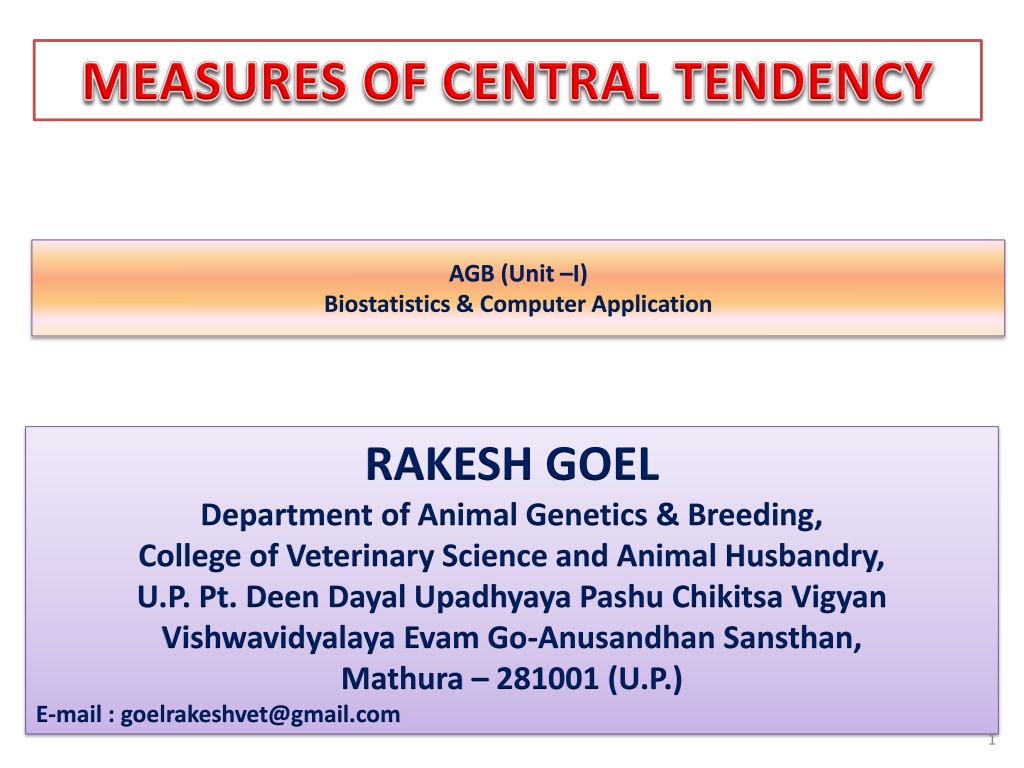Toxicology of Plants: Lectins and Toxicity in Animals
Lectins are carbohydrate-binding proteins found in plants, with the ability to survive digestion and trigger harmful reactions in consumers. Plants containing lectins like Abrus precatorius can have toxic effects on animals, disrupting metabolism and promoting organ abnormalities. The toxic principle Abrin in A. precatorius is similar to viper snake venom, inhibiting protein synthesis and causing cell death.
Download Presentation

Please find below an Image/Link to download the presentation.
The content on the website is provided AS IS for your information and personal use only. It may not be sold, licensed, or shared on other websites without obtaining consent from the author.If you encounter any issues during the download, it is possible that the publisher has removed the file from their server.
You are allowed to download the files provided on this website for personal or commercial use, subject to the condition that they are used lawfully. All files are the property of their respective owners.
The content on the website is provided AS IS for your information and personal use only. It may not be sold, licensed, or shared on other websites without obtaining consent from the author.
E N D
Presentation Transcript
AGB (Unit I) Biostatistics & Computer Application RAKESH GOEL Department of Animal Genetics & Breeding, College of Veterinary Science and Animal Husbandry, U.P. Pt. Deen Dayal Upadhyaya Pashu Chikitsa Vigyan Vishwavidyalaya Evam Go-Anusandhan Sansthan, Mathura 281001 (U.P.) E-mail : goelrakeshvet@gmail.com 1
According to Croxten and Cowden An average is a single value within the range of the data that is used to represent all the values in the series . A statistical measure used for representing the centre of central value of a set of observations is known as "Measure of Central Tendency". It is also called as Measure of first order .
An ideal measure of central tendency should possess the following properties- I. It should be rigidly defined i.e. it has a fixed and finite value II. It should be easy to understand III. It should be easy to calculate IV. Its calculation should be based on all the observations V. It should be capable for further algebraic treatment VI. It should not be affected by extreme values of the observations VII.It should be least affected by fluctuations of sampling
Some of the important averages may be classified as under: Arithmetic Mean (A.M.) Geometric Mean (G.M.) Harmonic Mean (H.M.) Weighted Mean (W.M.) Median (Md) Mode (Mo)
It is a number obtained by dividing the given observations by their number. If x1, x2, x3, ,xn are n observations, then the arithmetic mean denoted by, is given by- x X = = x x x + + + .......... __ 1 2 n n n Computation of A.M. In case of individual values: If x1, x2, x3, ,xn are n observations in a series, then the Arithmetic Mean (A.M.) is calculated by two methods (Direct or Shortcut) (i) Direct method: = x x x + + + .......... x __ = 1 2 n X n n
(ii) Shortcut method: d d d + + + .......... d __ = + = + 1 2 n X a a n n Here, a = Assumed mean; d = Deviation about assume mean = X - a X a = ? d = X a x1 X2 . d1 = x1 -a d2 = x2 -a . . . xn X dn = xn -a d Remark: The sum of the deviations of a given set of observations from the arithmetic mean is equal to zero. Symbolically, ( X = ) 0 X
In case of discrete frequency distribution: If x1, x2, x3,,xn are n observations with corresponding frequencies f1,f2,f3, ., fn, respectively. Then the Arithmetic Mean (A.M.) is calculated by two methods (Direct or Shortcut) (i) Direct method: x f x f + + = x f = + .......... fx __ 1 2 n 1 2 n X N N (ii) Shortcut method: d d d f f f + + + .......... fd __ = + = + 1 2 n 1 2 n X a a N N X f fX a = ? d = X a fd x1 X2 . f1 f2 . f1x1 f2x2 . d1 = x1 -a d2 = x2 -a . f1d1 f2d2 . . . . . . xn fn fnxn fX dn = xn -a fndn fd f = N
In case of continuous frequency distribution: If C1C2,C2C3,,CnCn+1 are class intervals of data with corresponding frequencies f1,f2,f3, ., fn, respectively. Then the Arithmetic Mean (A.M.) is calculated by two methods (Direct or Shortcut) (i) Direct method: m f m f + + = m f = + .......... fm __ 1 2 n 1 2 n X N N (ii) Shortcut method: d d d f f f + + + .......... fd __ = + = + 1 2 n 1 2 n X a a N N Here, m = Mid-value; d = m a; a = Assumed mean Class interval f m = Mid value fm a = ? d = m a fd C1 C2 f1 m1 f1m1 d1 = m1 -a f1d1 C2 C3 f2 m2 f2m2 d2 = m2 -a f2d2 . . . . . . . . . . . . Cn Cn+1 fn mn fnmn fm dn = mn -a fndn fd f = N
Merits of Arithmetic Mean It should be rigidly defined i.e. it has a fixed and finite value It should be easy to understand It should be easy to calculate Its calculation should be based on all the observations It should be capable for further algebraic treatment It should be least affected by fluctuations of sampling Demerits of Arithmetic Mean It is very much affected by extreme values of the observations, because it has a tendency towards the higher values of the given data. If any observation is missing in the series, it can not be calculated. It can be a value that does not exist in the series. Uses of Arithmetic Mean It is a common average and has a wide use in all the subjects of studies, like-Average production, average price, etc.
It is defined to be the nth root of the product of the n quantities of a series. Symbolically, if x1, x2, x3, , xn are the values of n items of the given series. Then, it is defined as- 1 = M . . ( . ........ ) G x x nx n 1 2 When the number of observations is large, the task of determining geometric mean from the following formula- log x = M . . log G Anti n
Computation of G.M. In case of individual values: If x1, x2, x3, ,xn are n observations in a series, then the Geometric Mean (G.M.) is calculated by log x = M . . log G Anti n X Log X x1 X2 . Log x1 Log x2 . . . xn Log xn Log X
In case of discrete frequency distribution: If x1, x2, x3, ,xn are n observations with corresponding frequencies f1,f2,f3, ., fn, respectively. Then the Geometric Mean (G.M.) is calculated by = Anti M G log . . log f x N X f Log X f. Log X x1 X2 . f1 f2 . Log x1 Log x2 . f1 .log x1 f2 .log x2 . . . . . xn fn Log xn fn .log xn f .log X f = N
In case of continuous frequency distribution: If C1C2,C2C3,,Cn Cn+1 are class intervals of data with corresponding frequencies f1,f2,f3, ., fn, respectively. Then the Geometric Mean (G.M.) is calculated by = Anti M G log . . log f m N m = Mid value CI f Log m f. Log m m1 C1-C2 C2-C3 . f1 f2 . Log m1 Log m2 . f1 .log m1 f2 .log m2 . m2 . . . . . . mn Cn-Cn+1 fn Log mn fn .log mn f .log m f = N
Merits of Geometric Mean It should be rigidly defined i.e. it has a fixed and finite value Its calculation should be based on all the observations It should be capable for further algebraic treatment It should be least affected by fluctuations of sampling Demerits of Geometric Mean It should not be easy to understand It should not be easy to calculate It is very much affected by extreme values of the observations, because it has a tendency towards lower values of the given data. It is undefined if any of the observation is negative or zero. Uses of Geometric Mean It is very useful in dealing with ratio and rates. It has a special use when smaller items of the series are to be given more weightage. Comparatively small weight is given to large items and large weight to small items. It is also used in case of Index number, percentage, etc.
It is the reciprocal of the arithmetic average of the reciprocals of the values of its various items. Symbolically, if x1, x2, x3, .., xn are the values of n items of the given series. Then, it is defined as- n M H ......... 3 2 1 n = = . . 1 1 1 1 1 + + + + X x x x x n Computation of H.M. In case of individual values: If x1, x2, x3, ,xn are n observations in a series, then the Harmonic Mean (H.M.) is calculated by n M H ......... 3 2 1 n = = . . 1 1 1 1 1 + + + + X x x x x n X x1 X2 . . xn 1/X 1/x1 1/x2 . . 1/xn (1/X)
In case of discrete frequency distribution: If x1, x2, x3,,xn are n observations with corresponding frequencies f1,f2,f3, ., fn, respectively. Then the Harmonic Mean (H.M.) is calculated by N = M . . H f X Where, N = f1+f2+f3+ ..+fn X f f/X x1 X2 . f1 f2 . f1/x1 f2/x2 . . . . xn fn fn/xn f/X f = N
In case of continuous frequency distribution: If C1C2,C2C3,,Cn Cn+1 are class intervals of data with corresponding frequencies f1,f2,f3, ., fn, respectively. Then the Geometric Mean (G.M.) is calculated by = M H . . N f m CI f m f/m C1-C2 C2-C3 . f1 f2 . m1 m2 . f1/m1 f2/m2 . . . . . Cn-Cn+1 fn mn fn/mn f/m f = N Relationship between A.M., G.M. and H.M. For any series or frequency distribution, the value of arithmetic mean (A.M.), geometric mean (G.M.) and harmonic mean (H.M.) are different and their values always follow the following inequality- H.M. G.M. A.M.
Merits of Harmonic Mean It should be rigidly defined i.e. it has a fixed and finite value, Its calculation should be based on all the observations, It should be capable for further algebraic treatment, It should be least affected by fluctuations of sampling. Demerits of Harmonic Mean It should not be easy to understand, It should not be easy to calculate, It is very much affected by extreme values of the observations,because it gives more weight to small observation. It is undefined if any of the observation is negative or zero. Uses of Harmonic Mean It has a special use when smaller items of the series are to be given still more weightage. It is also used in case of price data when prices are given in terms of quantity per unit of money (i.e. kg/Rs.). It is also used in averaging the velocities.
The arithmetic mean gives equal importance (weight) to all the observations in a series. Thus weighted mean is used in case when the relative importance of all the items is not equal. Symbolically, if x1, x2, x3, .., xn are the values of n items and w1, w2, w3, .., wn for their respective weights of the given series. Then, it is defined as- ( ( + w w 2 1 ) wx + + + ........ w x w x w x = = 1 1 2 2 M . . n n W ) + + ........ w w n X W WX x1 X2 . w1 w2 . w1.x1 w2.x2 . . . . xn wn W wn.xn WX
Merits of Weighted Mean It should be rigidly defined i.e. it has a fixed and finite value It should be easy to understand It should be easy to calculate Its calculation should be based on all the observations It should be capable for further algebraic treatment It should be least affected by fluctuations of sampling Demerits of Weighted Mean It is very much affected by extreme values of the observations, because it has a tendency towards the higher values of the given data. If any observation is missing in the series, it can not be calculated. It can be a value that does not exist in the series. Uses of Weighted Mean The weighted mean is also known as overall mean i.e. when component means are given and we want to calculate the mean for the total, then weighted mean is used. It is used to calculate birth rate, death rate, etc.
Median may be defined as the middle most or central value when the items are arranged in ascending or descending order of magnitude. if x1, x2, ..,xn are the values of n items of the given series. Then, in case of odd number of items in a data, it is defined as- n Median 2 th + 1 = item In case of even number of items in a data, then th th n n + + 1 item item 2 2 = Median 2
Computation of Median In case of individual values: If x1, x2, x3, ,xn are n observations in a series. Then, in case of odd number of items in a data, Median is defined as- + = th 1 n Median item 2 For Example: Calculate median for marks (out of 10) in biostatistics obtained by five students in a class: Marks: 7 8 4 6.5 9 Answer: Arrange the observations in ascending order of their magnitude of marks: 4, 6.5, 7, 8, 9 Since the number of observations is odd (5), the median is the value of {(5+1)/2}th item i.e. (3)th item, Thus, Median = 7
In case of even number of items in a data, then th th n n + + 1 item item 2 2 = Median 2 For Example: Calculate median for the following daily milk yield (litres) of 6 Sahiwal cows. Daily milk yield (litres):15 10 8 12 7 11 Answer: Arrange the observations in ascending order of their magnitude of Sahiwal cows : 7, 8, 10, 11, 12, 15 Since the number of observations is even (6), the median is the value of {(3)th item + (4)th item}/2, Thus, Median = (10 + 11)/2 = 10.5 litre
Discrete frequency distribution: In this case, the procedure of determining the median is the same as that of an individual series. The procedure consists of the following steps- Compute cumulative frequencies. i.e., if the order of the discrete frequency distribution is ascending, we calculate less than type cumulative frequency. Find out the median number i.e. Median Number = {(N+1)/2}th value = (N/2)th value This median number is seen in the cumulative frequency column and the cumulative frequency which is either equal to this median number or first greater than, it is encircle. The value of item against this encircled cumulative frequency is the median. ( In case of N is odd) ( In case of N is even)
For Example: Calculate median for body weight (kg) of 5 dogs as given in the following frequency table: Body weight (kg) : 20 No. of dogs : 5 25 8 30 16 35 7 40 4 Answer: Here, order of the discrete frequency distribution is ascending, then we calculate less than type cumulative frequency. Body weight (X) No. of dogs(f) Cumulative frequency 20 5 5 25 8 13 30 16 29 35 7 36 40 4 40 N= 40 Here, N is even, than Median No. = (40/2)th value = (20)th value This median number seen in the cumulative frequency column. The value of item against this encircled cumulative frequency is the median. Therefore, Median = 30.
Continuous frequency distribution: In this case, we first locate the median class by cumulating the frequencies until median number is reached. Finally, the median is determined within this class. The procedure thus involves the following steps- Compute cumulative frequencies. Find out the median number. Locate the median class in cumulative frequency column where the size of median number falls. Obtain the median value by applying the formula- ( l l Median + = 1 )( f ) l m c 2 1 2l 1l Where, = Lower limit of the median class, = Upper limit of the median class, N = Total Frequency; f = Frequency of the median class; and C = Cumulative frequency of the class preceding the median class, m = Median number
For Example: Calculate median for body weight (kg) of 5 dogs as given in the following frequency table: Body weight (kg) : 20-25 25-30 No. of dogs : 5 7 30-35 17 35-40 8 40-45 3 Answer: Here, order of the continuous frequency distribution is ascending, then we calculate less than type cumulative frequency. Body weight (C.I.) No. of dogs(f) Cumulative frequency 20-25 5 5 25-30 7 12 30-35 17 29 35-40 8 37 40-45 3 40 N= 40 Here, N is even, than Median No. = (40/2)th value = (20)th value This median number seen in the cumulative frequency column. The interval of class against this encircled cumulative frequency is the median class.
Class interval (30-35) is the median class. For calculating exact value of median, using formula ( )( f ) l l m c = + 2 1 Median l 1 Here, 2l 1l = 30; = 35; m = 20; c = 12; f = 17 Therefore, ( )( ) 35 30 20 12 40 = + = + = + = 30 30 30 . 2 35 32 35 . Median 17 17
Merits of Median It should be rigidly defined i.e. it has a fixed and finite value It should be easy to understand It should be easy to calculate It is not affected by extreme values of the observations Demerits of Median Its calculation should not be based on all the observations It is not capable for further algebraic treatment It should be affected by fluctuations of sampling In a continuous frequency distribution, the value of median is calculated by the formula. This formula is based on the assumption that all the frequencies of the class are uniformly distributed over the interval which is not always true . If number of items in a series is even than it does not lie in the series. Uses of Median It has a special use in the qualitative data. i.e. data based on honesty, intelligence, efficiency, etc. When continuous frequency distribution has opened end classes then it can be calculated easily. The sum of absolute deviations of the observations from the median is least.
Mode is that value, which occurs most often in a series. In other words, mode is the most frequently occurring value in a data set. The mode always lies in a frequency distribution at a point of greatest density. If there is only one item which has greatest frequency in a series, than such series is known as Uni-modal series. If in a series, there are two items which have maximum as well as equal frequencies, such series is known as Bi-modal series. If in a series, there are three items which have occurred maximum as well as equal frequencies, such series is known as Tri-modal series. If in a series, there are more than three items which have maximum as well as equal frequencies, such series is known as Multi-modal series.
Computation of Mode In case of individual values: If x1, x2, x3, ,xn are n observations in a series. Then, for finding mode of a given series count number of times the various values repeat themselves. The value which occur maximum number of times is the mode. For Example: Calculate median for marks (out of 10) in biostatistics obtained by eight students in a class: Marks: 7 8 4 6.5 9 7 6 5 Answer: Find the number which occurs most frequently which is 7 occurring 2 times. Thus, Mode = 7
In case of discrete frequency distribution: If x1, x2, x3,,xn are n observations with corresponding frequencies f1,f2,f3, ., fn, respectively. Then, mode can be determined by inspection. Here, the variate having maximum frequency will be taken as mode. For Example: Calculate mode for body weight (kg) of 5 dogs as given in the following frequency table: Body weight (kg) : 20 No. of dogs : 5 25 8 30 16 35 7 40 4 Answer: From the above data the variate value 30 has occurred the maximum frequency i.e. 16. Thus, Mode = 30.
In case of continuous frequency distribution: If C1C2,C2C3,,Cn Cn+1 are class intervals of data with corresponding frequencies f1,f2,f3, ., fn, respectively. Then the same procedure of grouping method mentioned in discrete distribution is adopted for determining the modal class of a continuous frequency distribution. After determining the modal class, the exact value of the mode is obtained by the formula- ( 1 ) ( l M Mode o + = )( ) l l f f 2 2 1 1 0 f f f 1 0 2 1l 2l Where, = Lower limit of the modal class, = Upper limit of the modal class, f0 = Frequency of the preceding modal class, f1 = Frequency of the modal class; and f2 = Frequency of the succeeding class
For Example: Calculate Mode for weekly milk yield (litres) of Hariana cows as given in the following frequency table: Weekly milk yield (Litre) : 0-10 Number of cows : 4 10-20 11 20-30 23 30-40 19 40-50 13 Answer: From the above data the interval of class interval (20-30) have been occurred the maximum frequency i.e. 23. Therefore, Class interval (20-30) is the modal class. Thus, for calculating the exact value of mode, we use the formula- ( 1 ) ( l M Mode o + = )( ) l l f f 2 2 1 1 0 f f f 1 0 2 2l 1l Here, = 20; = 30; f0 = 11; f1 = 23; and f2 = 19 Therefore; ( )( 11 ( ) 30 20 23 11 = + = 5 . 7 + = ( ) 20 20 27 5 . Mode M o + 2 23 19 ) x
Merits of Mode It should be easy to understand It should be easy to calculate It is not affected by extreme values of the observations It should not be affected by fluctuations of sampling. Demerits of Mode It should not be rigidly defined. Its calculation should not be based on all the observations It is not capable for further algebraic treatment Uses of Mode It is a useful average for many practical situations, such as, average size of shoe, average price of commodity, average type of dress in readymade garments, etc. It is widely used in the field of metrological forecasts.























